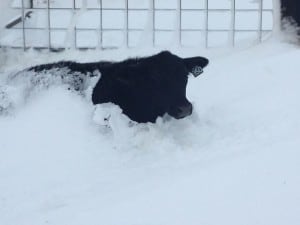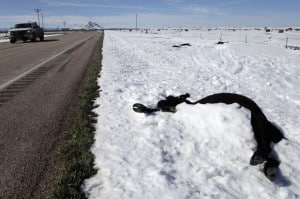AFRC Explains Position as Government Slimdown Ends For A While
Something different: White-nose syndrome of bats, and national forests
This hasn’t gotten huge attention in the West yet, but it will if and when (probably the latter) this wildlife disease arrives out here. In the eastern U.S., this contagious fungal disease (first observed only a few years ago in New York and Vermont) has devastated several species of bats and obliterated some huge hibernating colonies, killing literally millions of bats. It has spread rapidly to westward and southward, and may be ready to make the leap to the Rockies. Federal and state wildlife folks are very worried about this disease, as they should be.
I’m not a bat expert by any means, but have been working on the epidemiology of this disease with colleagues from USFS and Idaho Fish & Game, both of whom are incredibly knowledgeable and devoted to the study and conservation of these animals.
We have a paper coming out later this month or next, on WNS epidemiology as it relates to potential spread of the pathogen in western bat populations, if anybody’s interested you can read the pre-publication which I have posted here: http://gknudsenlaw.com/wp-content/uploads/2013/WNS.pdf (hopefully the journal won’t mind).
I presented some of this work at the national WNS workshop in Boise last month, sponsored by FWS, ironically the same week that I was arguing a case in federal court just down the street against USFS and FWS. But as my FS colleague noted, we should never let a little lawsuit spoil a good friendship.
If anyone’s interested, here’s some recent news regarding FWS activity on ESA listing of some WNS-threatened bats, these guys have an excellent website (I’m not affiliated): http://www.endangeredspecieslawandpolicy.com/2013/10/articles/listing-decision/with-the-conclusion-of-the-shutdown-the-us-fish-and-wildlife-service-gets-back-to-work/
And another bit of information on a CBD lawsuit to FOIA bat information from USFS in Idaho and Montana, I’m not sure the status of that and again I’m not affiliated in any way (though a little surprised, USFS usually responds pretty well to FOIA requests) http://www.biologicaldiversity.org/news/press_releases/2012/white-nose-syndrome-05-16-2012.html
Here’s a photo of a bat with typical symptoms, fungal sporulation on muzzle and wings, this one’s alive but not for long.
Fire-Suppression Funding Restored
A news brief from the National Association of State Foresters. The Continuing Resolution wasn’t “clean,” but this is a good thing.
The legislation signed into law early Thursday didn’t just end the 16-day-old partial government shutdown, it also paid back $636 million in fire transfer funds moved from other accounts to battle wildfires in the 2012-2013 season.
“Funding to restore budgets that have been drained through fire borrowing is a critical piece of this legislation,” Idaho Rep. Mike Simpson said in a statement. “It means (the government) can do the restoration work and hazardous-fuels removal needed to reduce the risk of catastrophic fires next year.”
Alan Rowsome, a budget expert at The Wilderness Society, said Congress deserves credit for recognizing that the Forest Service and the Interior Department must be repaid. “This is a good, important step,” Rowsome said in an interview. “But I think it also underscores the fact that the way we’re budgeting for fires is not adequate.”
Welcome Back Treat – Great Photos from Bob Berwyn

Well we’re discussing the same old things here for the most part, but one thing you would not have wanted to miss are these amazing photos on Bob Berwyn’s blog. His comment on Twitter reminded me..
Welcome Back, Feds!
It was great to hear your voices again … we missed you :)!
Had the occasion to call a Supervisor’s Office.. told the receptionist that I was glad to have them back and I appreciate their service. Please consider doing suchlike when you talk to your favorite Fed (or even a random one you happen to be talking to). Positive words are cheap, yet effective at making the world a better place, IMHO.
Judge issues order lifting federal suspension of logging sales
Pointless at this point?
Judge issues order lifting federal suspension of logging sales
Phil Taylor, E&E reporter
Published: Thursday, October 17, 2013
A federal judge in Oregon today issued a restraining order blocking the Obama administration from enforcing its earlier suspension of timber sales during the government shutdown.
The order by Judge Owen Panner of the U.S. District Court for the District of Oregon came the same day the Bureau of Land Management and Forest Service directed regional staff to begin allowing timber contractors to resume operations with the shutdown over.
The order follows a lawsuit filed this week by the American Forest Resource Council and three wood products manufacturing companies in the Pacific Northwest that argued the administration’s suspension of timber sales during the 16-day government shutdown was illegal (E&ENews PM, Oct. 15).
Tom Partin, president of AFRC, today said the judge did not rule on the merits of the suspensions but issued the order so individual contractors do not have to wait to receive approval to return to work.
“It will take a few days to get those out to the folks in the forest,” Partin said. “We greatly appreciate the judge’s [temporary restraining order] today.”
The industry had argued in the lawsuit that the suspensions were illegal because the supervision of logging activities is not “critical” and therefore activity should have continued in the absence of appropriations.
It remains to be seen whether any companies will file breach-of-contract claims against the government for lost production during the shutdown, which came at a critical time for loggers after the wildfire season and before the onset of November rains.
“Timber Trouble” in Wisconsin
Since Norman brought up Wisconsin, and I had seen this earlier, thought it would be a good time to post this.
Buried deep in Wisconsin’s northwoods is a story that warrants statewide attention.
In the coming days, the Gannett Wisconsin Media Investigative Team will bring you “Timber Trouble.”
Our three-part series focuses on the growing mistrust between the logging industry and the national forest service.
Gannett Wisconsin Media Investigative Team reporter Nick Penzenstadler and Post-Crescent Media photojournalist William Glasheen traveled north to do the reporting, photo and video work for the “Timber Troubles” project..
The Chequamegon-Nicolet National Forest and Laona area, in Forest County, serve as ground zero for our report.
Penzenstadler and Glasheen investigated whether the timber harvests inside northern Wisconsin’s national forest are being mismanaged. As a result of smaller harvests, the number of logging jobs has plummeted. That in turn has triggered a huge decline in student enrollment for Laona schools because of a drop in the Forest County population as people have had to move elsewhere in search of work.
It’s an intensely emotional issue, said Penzenstadler, adding that it’s hard to overstate the frustration of people in the logging and timber industry in northern Wisconsin.
They’re exasperated, disheartened and discouraged.
Their way of life is at stake. Their local school districts, businesses and economy are on the brink of collapse — and it does not have to be this way.
Millions of board feet of wood could be taken out of the Chequamegon-Nicolet while still preserving important portions of the forest.
The author says it merits “statewide attention.” I would think that the situation in the Lake States and the west merits national attention. If someone finds a story, please post in a comment. Required: in national news media, looks at situation nationally.
UPDATE: Looks like the entire series, which includes articles and video, is now available on-line. -mk
Concessionaires File Lawsuit re Shutdown
Here’s a link to the courthouse news service article on the concessionaire’s lawsuit.
The National Forest Recreation Association and co-plaintiffs American Land & Leisure, Recreation Resource Management, and CLM Services sued the U.S. Forest Service in Federal Court.
They note acerbically that the shutdown of the federal government has cost their employees hundreds of jobs, and that “Congress has stated no intention to vote to restore campground concessioners’ ‘back pay.'”
They claim the Forest Service is “nonsensically asserting that, while recreating and camping in undeveloped areas is fine, recreating and camping in developed campgrounds and recreation areas run by trained, private concessioners who do not receive any federal funds creates a risk to property, public health and safety because the Forest Service has reduced funds.”
The companies say they do not get federal funding: “In fact, plaintiffs pay money to the federal government to operate.”
The Forest Service this month decided to close certain areas in the National Forest System and suspend all concessionaire operations at developed campground and recreation sites nationwide.
The plaintiffs are concessionaires at the sites, operating campgrounds in National Forests across the country. They say their services are crucial for the safety of campers, providing emergency first aid, restrooms and clean drinking water on federal campgrounds. They also repair parking lot potholes, fire hydrants and roads.
Since the shutdown of the federal government has closed campgrounds in federal forests, campers have been forced onto undeveloped areas, despite the companies’ autonomy from the federal government.
“Having people camp at developed campgrounds or recreate in developed areas operated by concessioners reduces the risks to public safety and resource damage,” the groups say.
They claim that “the reduction in Forest Service funding has absolutely no impact on the ability of concessioners to continue to ensure public safety and reduce risk of property damage.”
I continue to wish we could hear the logic for why ski areas are OK but concessionaires aren’t. Still haven’t got a phone call back from the furloughed public affairs folks.
The Great South Dakota Blizzard That Didn’t Happen
Here is a post from another blog demonstrating: 1) the lack of media attention to such a significant event in the Age of Global Warming, and 2) the growing power of bloggery in communicating and discussing important ideas and events in this Age of Internet Communications. 1152 comments and counting!

The Blizzard that Never Was – and its Aftermath on Cattle and Ranchers
October 8, 2013 by dawnwink | 1,152 Comments
The worst blizzard in recorded history of South Dakota just swept through the state. Tens of thousands of cattle are predicted dead and the much of the state is still without power. The Rapid City Journal reports, ”Tens of thousands of cattle lie dead across South Dakota on Monday following a blizzard that could become one of the most costly in the history of the state’s agriculture industry.”
The only reason I know this is because my parent’s ranch, the setting for Meadowlark, lies in the storm’s epicenter. Mom texted me after the storm. “No electricity. Saving power on phone. It’s really, really bad….” She turned on her phone to call me later that day. “There are no words to describe the devastation and loss. Everywhere we look there are dead cattle. I’ve never seen so many dead cattle. Nobody can remember anything like this.” Author of several books and infinite numbers of articles, Mom said, “I can’t imagine writing about this. I’m not going to take photos. These deaths are too gruesome. Nobody wants to see this.”
I searched the national news for more information. Nothing. Not a single report on any of major news sources that I found. Not CNN, not the NY Times, not MSNBC. I thought, Well, it is early and the state remains without power and encased in snow, perhaps tomorrow. So I checked again the next day. Nothing. It has now been four days and no national news coverage.
Meanwhile, ranchers on the plains have been dealt a crippling blow the likes that has not been experienced in living memory. The Rapid City Journal continues, ”Silvia Christen, executive director of the South Dakota Stockgrowers Association, said most ranchers she had spoken to were reporting that 20 to 50 percent of their herds had been killed. While South Dakota ranchers are no strangers to blizzards, what made Friday’s storm so damaging was how early it arrived in the season. Christen said cattle hadn’t yet grown their winter coats to insulate them from freezing wind and snow. In addition, Christen said, during the cold months, ranchers tend to move their cattle to pastures that have more trees and gullies to protect them from storms. Because Friday’s storm arrived so early in the year, most ranchers were still grazing their herds on summer pasture, which tend to be more exposed and located farther away from ranch homes.”
In addition to the financial loss, when a rancher loses an animal, it is a loss of years, decades, and often generations within families, of building the genetics of a herd. Each rancher’s herd is as individual and unique as a fingerprint. It is not a simple as going out to buy another cow. Each cow in a herd is the result of years of careful breeding, in the hopes of creating a herd reflective of market desirability, as well as professional tastes of the rancher. Cattle deaths of this magnitude for ranchers is the equivalent of an investment banker’s entire portfolio suddenly gone. In an instant, the decades of investment forever disappear. It is to start over again, to rebuild, over years and years.
Cattle have a very real money amount that ranchers and their families depend upon. This is also true of acreage and the size of a herd. This why you never, ever ask a rancher, “How big is your ranch?” or “How many cattle do you have?” These are the equivalents of, “So, how about you tell me the amount of money in your bank account?” With these losses, it is up to the rancher to divulge, or not, the number of head lost. It is not polite to ask, again the equivalent of asking, “So, how much money just evaporated from your bank account?” People outside of the ranching world often ask these questions with the best of intentions. They have no idea how these questions are experienced by the rancher.
People have asked me, “What can we say then?” On this occasion, a heartfelt, “I’m sorry for your loss,” goes a long, long way.
Here are two excellent pieces, written by local newspapers, on the loss and devastation to the living landscape:
Tens of Thousands of Cattle Killed in Friday’s Blizzard, Ranchers Say The Rapid City Journal
October Blizzard Taking Toll on Livestock, Ranch Radio KBHB
To ranch is not a job, it is a life. In Meadowlark, which takes place on my parent’s ranch, the main character, Grace, studies the economic situation of the ranch, “By lamplight, Grace pored over the columns of numbers that represented the ranch. The sound of the pencil against the paper rose from the page and drifted into the corners of the room. She studied rows and numbers, written and erased, then written and erased again…This was all this ranch was to the bank: Expenses and income—the quantities of the former far outnumbering those of the later.
Nowhere was there space for the things that represented the ranch’s true value. Headings such as Life, Hope, Dreams, and God-It’s-All-We’ve-Got did not exist. Nor was there room for Memories, Legacy, and Blood-and-Sweat. No item reflected the scent of the prairie grass after a summer rain. No place for the times Grace had rocked James and prayed that the land would sustain him through a lifetime. “
The prairie is a place of extremes, where the weather and land always take primacy, because they must. In Meadowlark, Grace writes in her journal, “The beauty. The bitterness. Not a land of mediocrity but of stunning beauty and brute force.”
The prairie experienced a summer of beauty, with rain we hadn’t seen in years. The prairie was lush with grass and cattle fat and glossy in the pastures. Now, we experience the brute force of the prairie, with tens of thousands of cattle dead and ranching families and communities left reeling. All of this death and destruction from The Blizzard that Never Was.
Mom just wrote, “As the days warm, more and more carcasses are exposed. So many have lost so much.”
I invite you to lift prayers and light to the people and animals of this region. When I told Mom there were so many people sending love, she said, “We feel it. It helps.”
If you’d like to leave your words of encouragement and prayers in the Comments section if this piece, I will make sure they get to those who most need to hear them now.

To subscribe and receive Dewdrops in your email, please enter your email address in the box under “Follow this blog via email” or click on the ‘Follow’ icon in lower right-hand corner of the blog’s screen and ‘Confirm Follow’ in the email you receive. To return to website: www.dawnwink.com


